Social Media Platforms in UK Retail: Asos/Topshop Marketing Strategy
VerifiedAdded on 2020/01/07
|20
|6770
|297
Report
AI Summary
This report investigates the use of social media platforms by UK retailers, specifically focusing on Asos and Topshop, to develop an integrated marketing and sales strategy. It explores the impact of social media on consumer buying habits, the advantages of online platforms, and the opportunities for businesses to link social media with online selling. The research addresses key questions regarding the impact of these platforms on consumer behavior, the UK apparel market's utilization of online sales and social media, and future opportunities for businesses. The literature review highlights the benefits of social media for retailers, including increased customer reach and lower costs. The report examines the changing consumer decision-making process, the role of social media in marketing strategies, and the impact of social media platforms on consumer buying habits. The report also includes screenshots from Asos and social media accounts to illustrate the marketing strategies employed by the retailers. This report is a valuable resource for understanding how social media is revolutionizing the retail industry.

To examine the use of social media platforms in Asos/ Topshop to develop integrated
marketing
marketing
Paraphrase This Document
Need a fresh take? Get an instant paraphrase of this document with our AI Paraphraser

Table of Contents
Research Questions.............................................................................................................................4
Literature Review...............................................................................................................................4
Research Methodology.....................................................................................................................14
How Does the Research Differ?.......................................................................................................17
References & Bibliography..............................................................................................................18
Research Questions.............................................................................................................................4
Literature Review...............................................................................................................................4
Research Methodology.....................................................................................................................14
How Does the Research Differ?.......................................................................................................17
References & Bibliography..............................................................................................................18
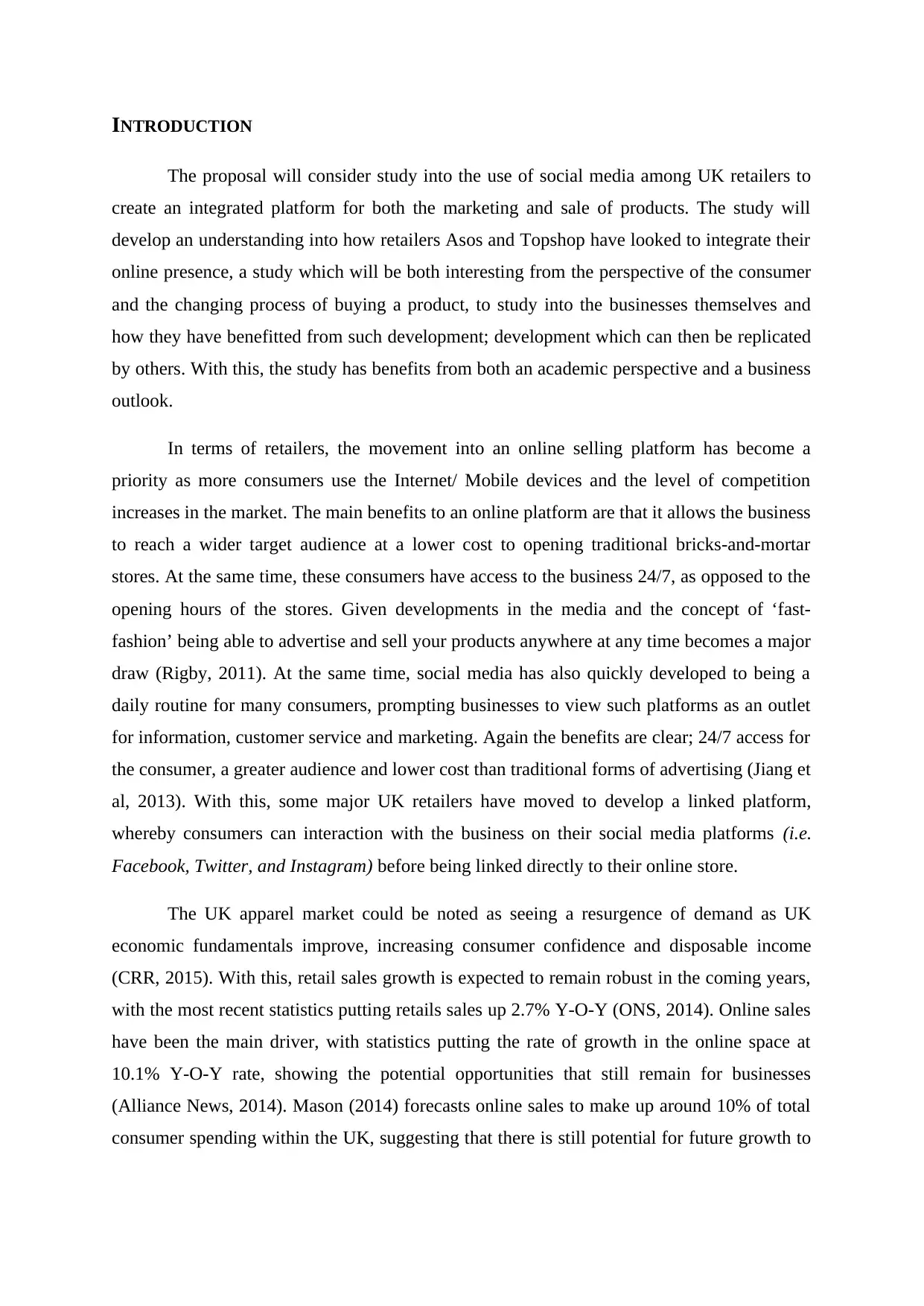
INTRODUCTION
The proposal will consider study into the use of social media among UK retailers to
create an integrated platform for both the marketing and sale of products. The study will
develop an understanding into how retailers Asos and Topshop have looked to integrate their
online presence, a study which will be both interesting from the perspective of the consumer
and the changing process of buying a product, to study into the businesses themselves and
how they have benefitted from such development; development which can then be replicated
by others. With this, the study has benefits from both an academic perspective and a business
outlook.
In terms of retailers, the movement into an online selling platform has become a
priority as more consumers use the Internet/ Mobile devices and the level of competition
increases in the market. The main benefits to an online platform are that it allows the business
to reach a wider target audience at a lower cost to opening traditional bricks-and-mortar
stores. At the same time, these consumers have access to the business 24/7, as opposed to the
opening hours of the stores. Given developments in the media and the concept of ‘fast-
fashion’ being able to advertise and sell your products anywhere at any time becomes a major
draw (Rigby, 2011). At the same time, social media has also quickly developed to being a
daily routine for many consumers, prompting businesses to view such platforms as an outlet
for information, customer service and marketing. Again the benefits are clear; 24/7 access for
the consumer, a greater audience and lower cost than traditional forms of advertising (Jiang et
al, 2013). With this, some major UK retailers have moved to develop a linked platform,
whereby consumers can interaction with the business on their social media platforms (i.e.
Facebook, Twitter, and Instagram) before being linked directly to their online store.
The UK apparel market could be noted as seeing a resurgence of demand as UK
economic fundamentals improve, increasing consumer confidence and disposable income
(CRR, 2015). With this, retail sales growth is expected to remain robust in the coming years,
with the most recent statistics putting retails sales up 2.7% Y-O-Y (ONS, 2014). Online sales
have been the main driver, with statistics putting the rate of growth in the online space at
10.1% Y-O-Y rate, showing the potential opportunities that still remain for businesses
(Alliance News, 2014). Mason (2014) forecasts online sales to make up around 10% of total
consumer spending within the UK, suggesting that there is still potential for future growth to
The proposal will consider study into the use of social media among UK retailers to
create an integrated platform for both the marketing and sale of products. The study will
develop an understanding into how retailers Asos and Topshop have looked to integrate their
online presence, a study which will be both interesting from the perspective of the consumer
and the changing process of buying a product, to study into the businesses themselves and
how they have benefitted from such development; development which can then be replicated
by others. With this, the study has benefits from both an academic perspective and a business
outlook.
In terms of retailers, the movement into an online selling platform has become a
priority as more consumers use the Internet/ Mobile devices and the level of competition
increases in the market. The main benefits to an online platform are that it allows the business
to reach a wider target audience at a lower cost to opening traditional bricks-and-mortar
stores. At the same time, these consumers have access to the business 24/7, as opposed to the
opening hours of the stores. Given developments in the media and the concept of ‘fast-
fashion’ being able to advertise and sell your products anywhere at any time becomes a major
draw (Rigby, 2011). At the same time, social media has also quickly developed to being a
daily routine for many consumers, prompting businesses to view such platforms as an outlet
for information, customer service and marketing. Again the benefits are clear; 24/7 access for
the consumer, a greater audience and lower cost than traditional forms of advertising (Jiang et
al, 2013). With this, some major UK retailers have moved to develop a linked platform,
whereby consumers can interaction with the business on their social media platforms (i.e.
Facebook, Twitter, and Instagram) before being linked directly to their online store.
The UK apparel market could be noted as seeing a resurgence of demand as UK
economic fundamentals improve, increasing consumer confidence and disposable income
(CRR, 2015). With this, retail sales growth is expected to remain robust in the coming years,
with the most recent statistics putting retails sales up 2.7% Y-O-Y (ONS, 2014). Online sales
have been the main driver, with statistics putting the rate of growth in the online space at
10.1% Y-O-Y rate, showing the potential opportunities that still remain for businesses
(Alliance News, 2014). Mason (2014) forecasts online sales to make up around 10% of total
consumer spending within the UK, suggesting that there is still potential for future growth to
⊘ This is a preview!⊘
Do you want full access?
Subscribe today to unlock all pages.

Trusted by 1+ million students worldwide
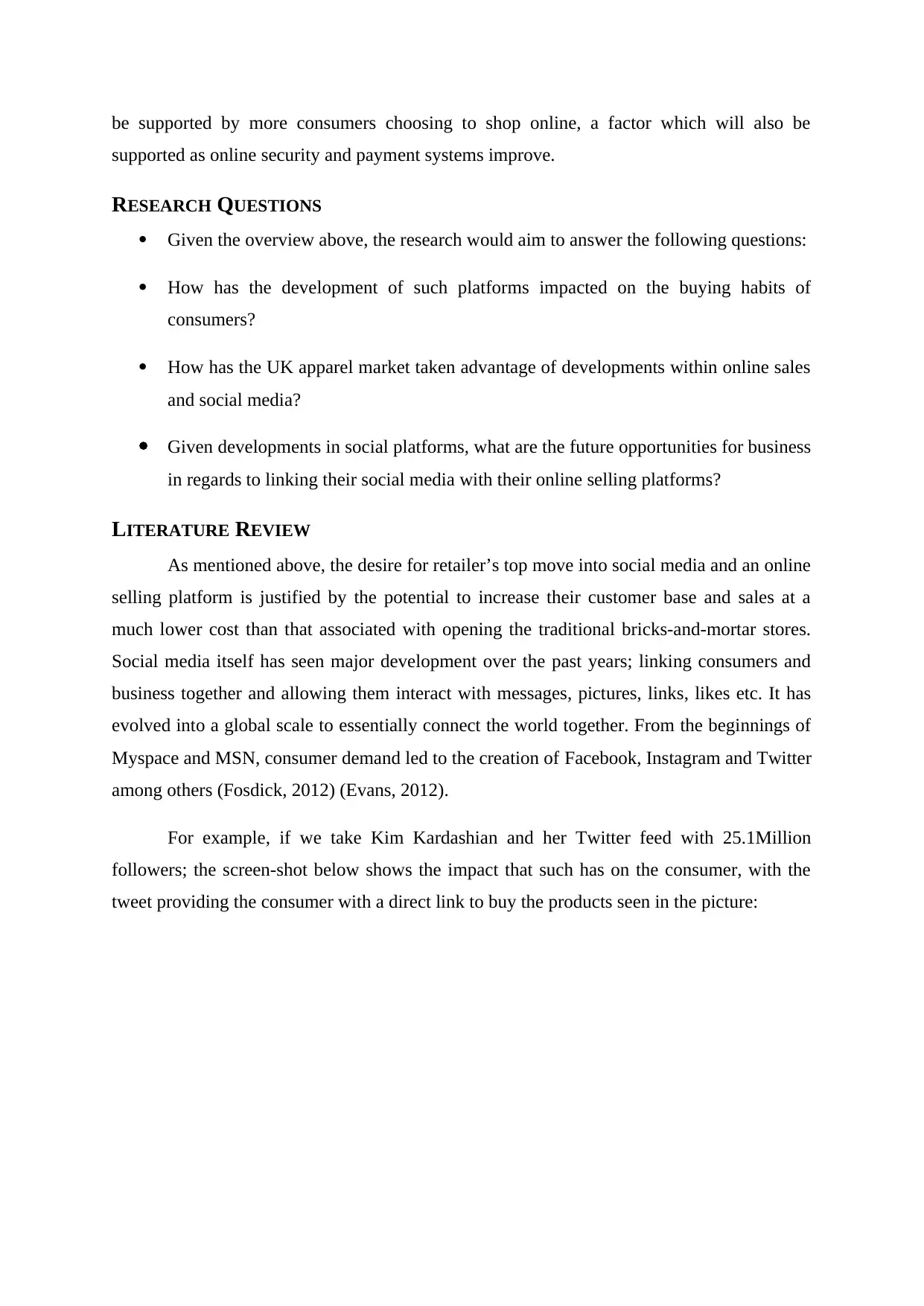
be supported by more consumers choosing to shop online, a factor which will also be
supported as online security and payment systems improve.
RESEARCH QUESTIONS
Given the overview above, the research would aim to answer the following questions:
How has the development of such platforms impacted on the buying habits of
consumers?
How has the UK apparel market taken advantage of developments within online sales
and social media?
Given developments in social platforms, what are the future opportunities for business
in regards to linking their social media with their online selling platforms?
LITERATURE REVIEW
As mentioned above, the desire for retailer’s top move into social media and an online
selling platform is justified by the potential to increase their customer base and sales at a
much lower cost than that associated with opening the traditional bricks-and-mortar stores.
Social media itself has seen major development over the past years; linking consumers and
business together and allowing them interact with messages, pictures, links, likes etc. It has
evolved into a global scale to essentially connect the world together. From the beginnings of
Myspace and MSN, consumer demand led to the creation of Facebook, Instagram and Twitter
among others (Fosdick, 2012) (Evans, 2012).
For example, if we take Kim Kardashian and her Twitter feed with 25.1Million
followers; the screen-shot below shows the impact that such has on the consumer, with the
tweet providing the consumer with a direct link to buy the products seen in the picture:
supported as online security and payment systems improve.
RESEARCH QUESTIONS
Given the overview above, the research would aim to answer the following questions:
How has the development of such platforms impacted on the buying habits of
consumers?
How has the UK apparel market taken advantage of developments within online sales
and social media?
Given developments in social platforms, what are the future opportunities for business
in regards to linking their social media with their online selling platforms?
LITERATURE REVIEW
As mentioned above, the desire for retailer’s top move into social media and an online
selling platform is justified by the potential to increase their customer base and sales at a
much lower cost than that associated with opening the traditional bricks-and-mortar stores.
Social media itself has seen major development over the past years; linking consumers and
business together and allowing them interact with messages, pictures, links, likes etc. It has
evolved into a global scale to essentially connect the world together. From the beginnings of
Myspace and MSN, consumer demand led to the creation of Facebook, Instagram and Twitter
among others (Fosdick, 2012) (Evans, 2012).
For example, if we take Kim Kardashian and her Twitter feed with 25.1Million
followers; the screen-shot below shows the impact that such has on the consumer, with the
tweet providing the consumer with a direct link to buy the products seen in the picture:
Paraphrase This Document
Need a fresh take? Get an instant paraphrase of this document with our AI Paraphraser
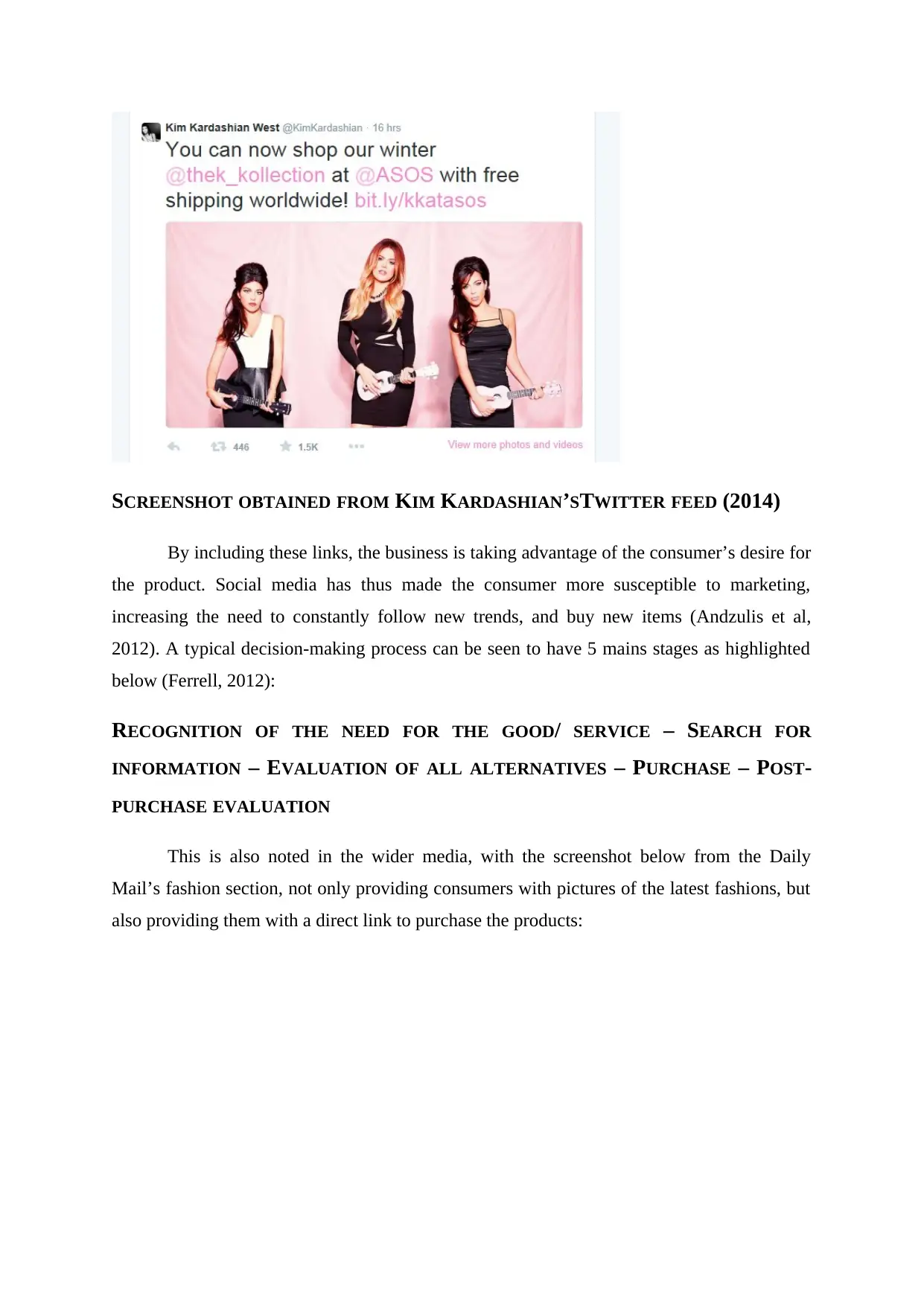
SCREENSHOT OBTAINED FROM KIM KARDASHIAN’STWITTER FEED (2014)
By including these links, the business is taking advantage of the consumer’s desire for
the product. Social media has thus made the consumer more susceptible to marketing,
increasing the need to constantly follow new trends, and buy new items (Andzulis et al,
2012). A typical decision-making process can be seen to have 5 mains stages as highlighted
below (Ferrell, 2012):
RECOGNITION OF THE NEED FOR THE GOOD/ SERVICE – SEARCH FOR
INFORMATION – EVALUATION OF ALL ALTERNATIVES – PURCHASE – POST-
PURCHASE EVALUATION
This is also noted in the wider media, with the screenshot below from the Daily
Mail’s fashion section, not only providing consumers with pictures of the latest fashions, but
also providing them with a direct link to purchase the products:
By including these links, the business is taking advantage of the consumer’s desire for
the product. Social media has thus made the consumer more susceptible to marketing,
increasing the need to constantly follow new trends, and buy new items (Andzulis et al,
2012). A typical decision-making process can be seen to have 5 mains stages as highlighted
below (Ferrell, 2012):
RECOGNITION OF THE NEED FOR THE GOOD/ SERVICE – SEARCH FOR
INFORMATION – EVALUATION OF ALL ALTERNATIVES – PURCHASE – POST-
PURCHASE EVALUATION
This is also noted in the wider media, with the screenshot below from the Daily
Mail’s fashion section, not only providing consumers with pictures of the latest fashions, but
also providing them with a direct link to purchase the products:
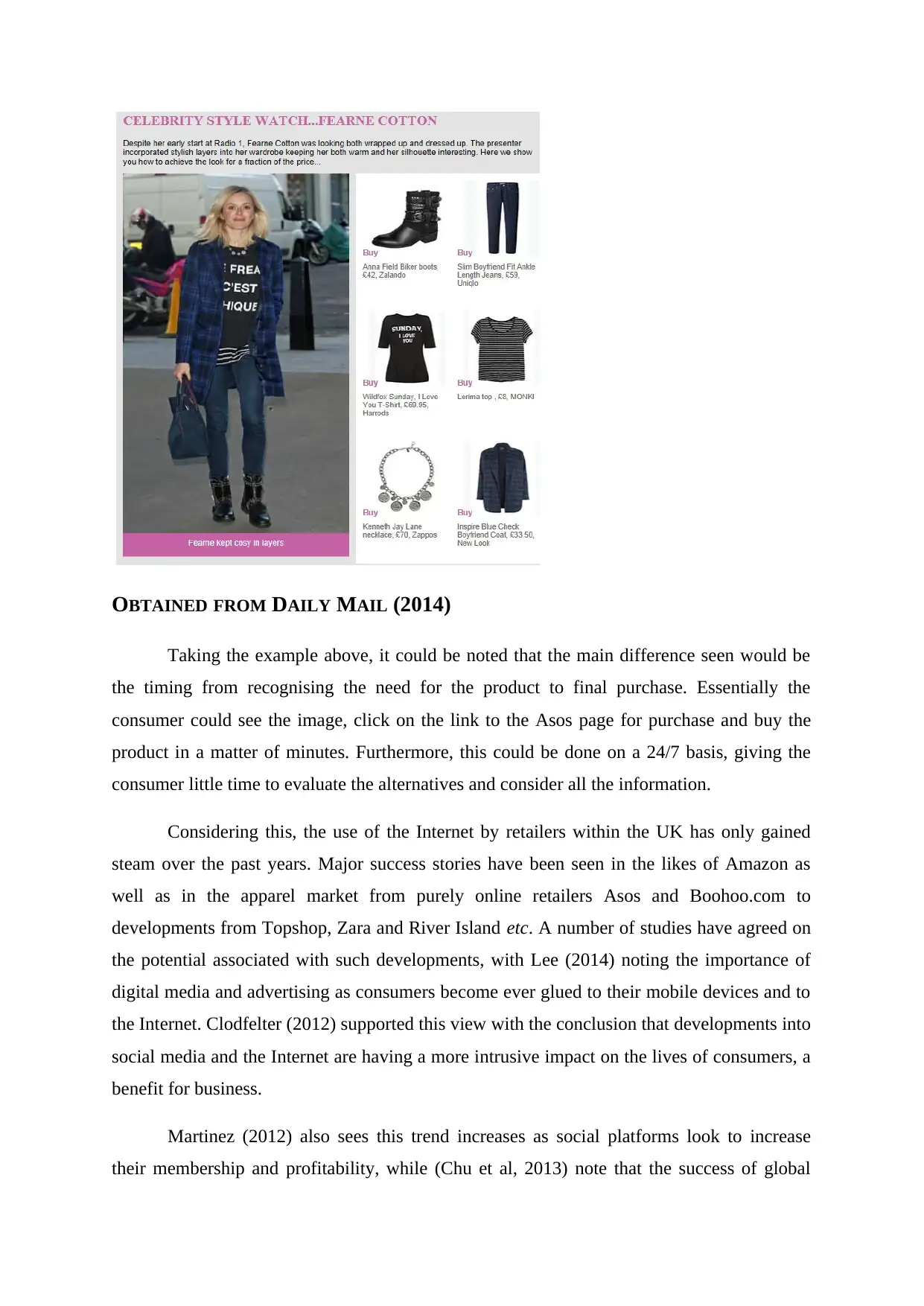
OBTAINED FROM DAILY MAIL (2014)
Taking the example above, it could be noted that the main difference seen would be
the timing from recognising the need for the product to final purchase. Essentially the
consumer could see the image, click on the link to the Asos page for purchase and buy the
product in a matter of minutes. Furthermore, this could be done on a 24/7 basis, giving the
consumer little time to evaluate the alternatives and consider all the information.
Considering this, the use of the Internet by retailers within the UK has only gained
steam over the past years. Major success stories have been seen in the likes of Amazon as
well as in the apparel market from purely online retailers Asos and Boohoo.com to
developments from Topshop, Zara and River Island etc. A number of studies have agreed on
the potential associated with such developments, with Lee (2014) noting the importance of
digital media and advertising as consumers become ever glued to their mobile devices and to
the Internet. Clodfelter (2012) supported this view with the conclusion that developments into
social media and the Internet are having a more intrusive impact on the lives of consumers, a
benefit for business.
Martinez (2012) also sees this trend increases as social platforms look to increase
their membership and profitability, while (Chu et al, 2013) note that the success of global
Taking the example above, it could be noted that the main difference seen would be
the timing from recognising the need for the product to final purchase. Essentially the
consumer could see the image, click on the link to the Asos page for purchase and buy the
product in a matter of minutes. Furthermore, this could be done on a 24/7 basis, giving the
consumer little time to evaluate the alternatives and consider all the information.
Considering this, the use of the Internet by retailers within the UK has only gained
steam over the past years. Major success stories have been seen in the likes of Amazon as
well as in the apparel market from purely online retailers Asos and Boohoo.com to
developments from Topshop, Zara and River Island etc. A number of studies have agreed on
the potential associated with such developments, with Lee (2014) noting the importance of
digital media and advertising as consumers become ever glued to their mobile devices and to
the Internet. Clodfelter (2012) supported this view with the conclusion that developments into
social media and the Internet are having a more intrusive impact on the lives of consumers, a
benefit for business.
Martinez (2012) also sees this trend increases as social platforms look to increase
their membership and profitability, while (Chu et al, 2013) note that the success of global
⊘ This is a preview!⊘
Do you want full access?
Subscribe today to unlock all pages.

Trusted by 1+ million students worldwide

business such as Amazon will only increase the desire for more businesses to move online.
Research by Vision Central (2013) noted Facebook as the top social platform among its
consumer surveys, as well as the remark that 40% of users from social media had gone on to
purchase an item when they shared/ liked the product on these sites. Other relevant authors in
the field include Brennan and Schafer (2010), Granger (2012), Bradford (2014) and Sherman
(2014). The picture from most is positive, supporting the view that development into these
platforms is vital for future growth and brand awareness; however at the same time Sherman
(2014) did note that business must ensure they have the resources to deal with potential
negatives associated with moving online, namely dealing with complaints, negative press and
fluctuations in demand.
The screenshot below has been obtained from the Facebook account of Asos, showing
how they link the customer directly with their online store, as well as also provide customer
service and support the corporate identity (seen in the comment section).
Research by Vision Central (2013) noted Facebook as the top social platform among its
consumer surveys, as well as the remark that 40% of users from social media had gone on to
purchase an item when they shared/ liked the product on these sites. Other relevant authors in
the field include Brennan and Schafer (2010), Granger (2012), Bradford (2014) and Sherman
(2014). The picture from most is positive, supporting the view that development into these
platforms is vital for future growth and brand awareness; however at the same time Sherman
(2014) did note that business must ensure they have the resources to deal with potential
negatives associated with moving online, namely dealing with complaints, negative press and
fluctuations in demand.
The screenshot below has been obtained from the Facebook account of Asos, showing
how they link the customer directly with their online store, as well as also provide customer
service and support the corporate identity (seen in the comment section).
Paraphrase This Document
Need a fresh take? Get an instant paraphrase of this document with our AI Paraphraser
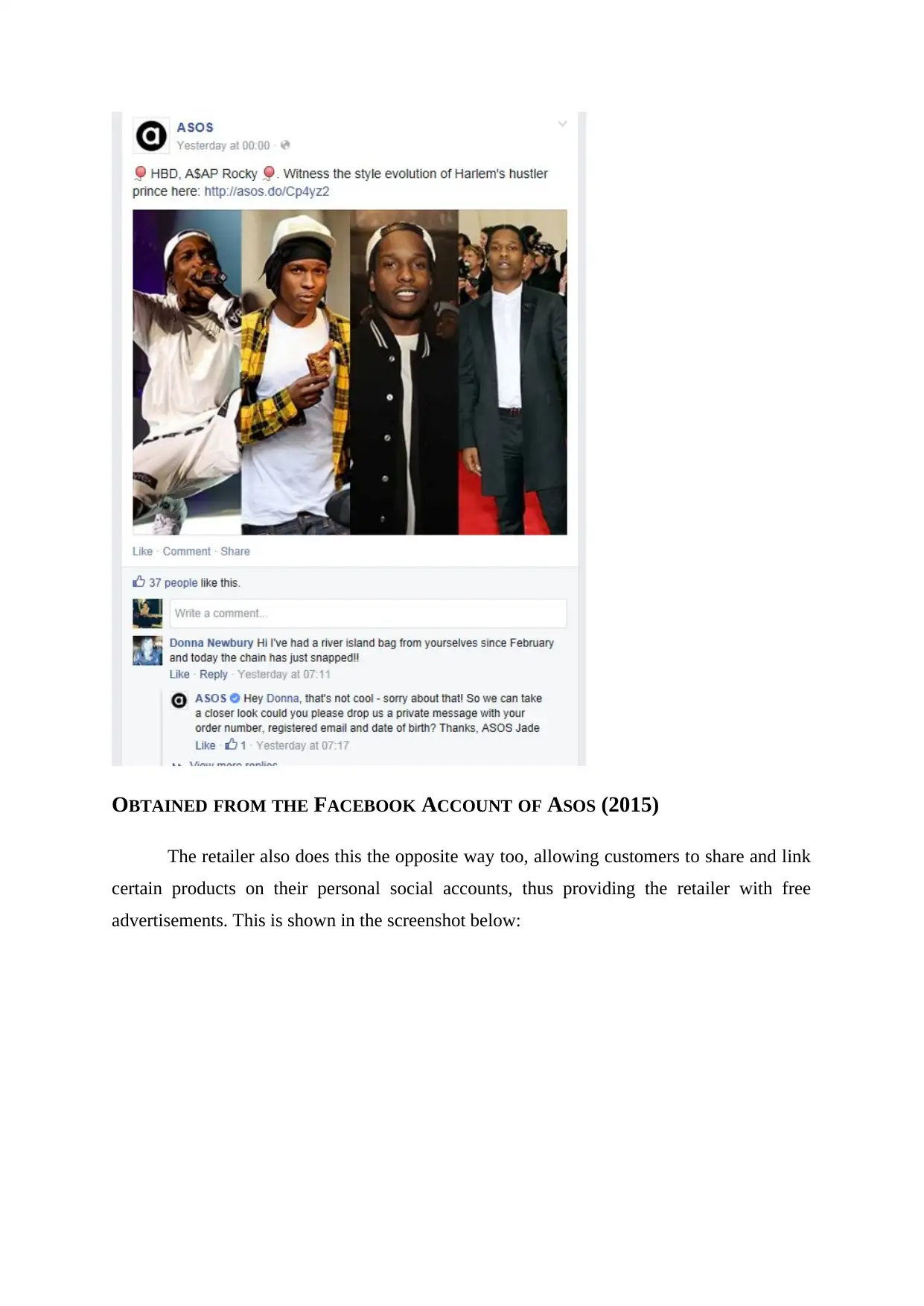
OBTAINED FROM THE FACEBOOK ACCOUNT OF ASOS (2015)
The retailer also does this the opposite way too, allowing customers to share and link
certain products on their personal social accounts, thus providing the retailer with free
advertisements. This is shown in the screenshot below:
The retailer also does this the opposite way too, allowing customers to share and link
certain products on their personal social accounts, thus providing the retailer with free
advertisements. This is shown in the screenshot below:
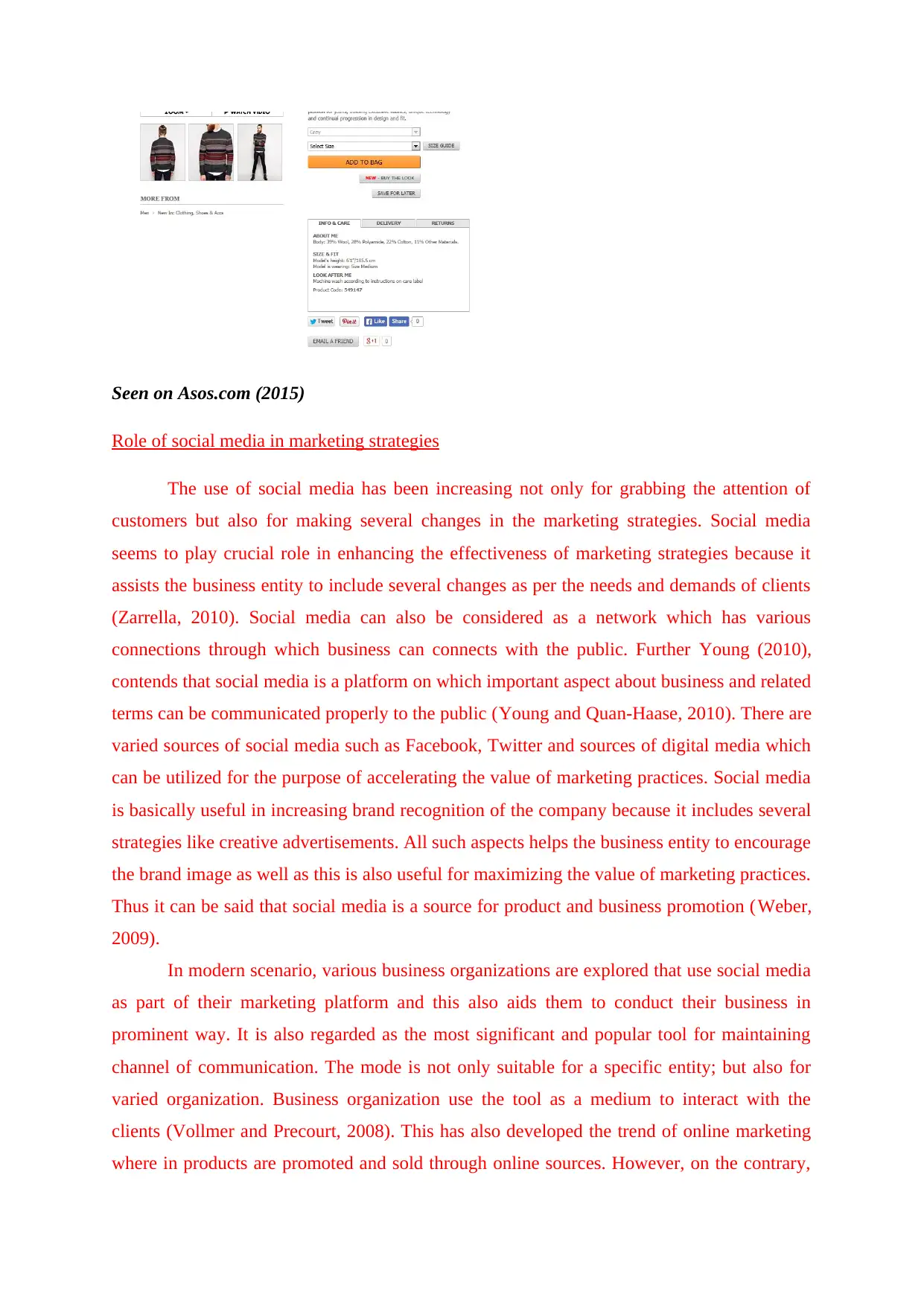
Seen on Asos.com (2015)
Role of social media in marketing strategies
The use of social media has been increasing not only for grabbing the attention of
customers but also for making several changes in the marketing strategies. Social media
seems to play crucial role in enhancing the effectiveness of marketing strategies because it
assists the business entity to include several changes as per the needs and demands of clients
(Zarrella, 2010). Social media can also be considered as a network which has various
connections through which business can connects with the public. Further Young (2010),
contends that social media is a platform on which important aspect about business and related
terms can be communicated properly to the public (Young and Quan-Haase, 2010). There are
varied sources of social media such as Facebook, Twitter and sources of digital media which
can be utilized for the purpose of accelerating the value of marketing practices. Social media
is basically useful in increasing brand recognition of the company because it includes several
strategies like creative advertisements. All such aspects helps the business entity to encourage
the brand image as well as this is also useful for maximizing the value of marketing practices.
Thus it can be said that social media is a source for product and business promotion (Weber,
2009).
In modern scenario, various business organizations are explored that use social media
as part of their marketing platform and this also aids them to conduct their business in
prominent way. It is also regarded as the most significant and popular tool for maintaining
channel of communication. The mode is not only suitable for a specific entity; but also for
varied organization. Business organization use the tool as a medium to interact with the
clients (Vollmer and Precourt, 2008). This has also developed the trend of online marketing
where in products are promoted and sold through online sources. However, on the contrary,
Role of social media in marketing strategies
The use of social media has been increasing not only for grabbing the attention of
customers but also for making several changes in the marketing strategies. Social media
seems to play crucial role in enhancing the effectiveness of marketing strategies because it
assists the business entity to include several changes as per the needs and demands of clients
(Zarrella, 2010). Social media can also be considered as a network which has various
connections through which business can connects with the public. Further Young (2010),
contends that social media is a platform on which important aspect about business and related
terms can be communicated properly to the public (Young and Quan-Haase, 2010). There are
varied sources of social media such as Facebook, Twitter and sources of digital media which
can be utilized for the purpose of accelerating the value of marketing practices. Social media
is basically useful in increasing brand recognition of the company because it includes several
strategies like creative advertisements. All such aspects helps the business entity to encourage
the brand image as well as this is also useful for maximizing the value of marketing practices.
Thus it can be said that social media is a source for product and business promotion (Weber,
2009).
In modern scenario, various business organizations are explored that use social media
as part of their marketing platform and this also aids them to conduct their business in
prominent way. It is also regarded as the most significant and popular tool for maintaining
channel of communication. The mode is not only suitable for a specific entity; but also for
varied organization. Business organization use the tool as a medium to interact with the
clients (Vollmer and Precourt, 2008). This has also developed the trend of online marketing
where in products are promoted and sold through online sources. However, on the contrary,
⊘ This is a preview!⊘
Do you want full access?
Subscribe today to unlock all pages.

Trusted by 1+ million students worldwide

Vollmer (2008), contends that social media is a time based activity in which business entities
have to consider each and every aspect for the market. Further, it consumes financial
resources because needs and clients of customers should be included in every aspect. Most of
the business entities are using social media tool as a mode of deriving suggestions and
recommendations from the clients (Tungate, 2005). Thus, from the above discussion, it can
be said that social media is tropically significant for all the business aspects. Being a
significant tool, many of the organizations are using this for the purpose of building the
platform for effective marketing
Social media aids the business entity to identify the needs and demands of clients and
the technique is also useful for the purpose of analyzing changing preferences of clients. In
contemporary scenario, almost everyone use different techniques of social media so as to
remain active and also to get information about all the aspects (Thvill and Bovee, 2010).
This aids in deriving adequate knowledge about the market aspects and apart from this,
customer can also get information about changing market trends. Social media helps the
business entities to set a platform through which products and services can be promoted.
Advertisements and other traditional forms of promotion could also be used in social media
so as to enhance its promotional aspects. Advertisements and other forms are useful for
business entities since that aids them to make the customers aware about business products
and market trends (Thelwall, 2008). Marketing strategies of the business entity can be
strengthened through adopting the modes of social media. Further, it is also useful for the
purpose of including creative elements in the business promotional aspects.
Social media platform impacts the buying habits of consumers
Social media technique is useful since it helps the business entity to persuade large
pool of customers towards business products and services. Steinfield (2009), contends that
social media aids the business entities to maintain direct and prominent relationship with the
clients which somewhere also ensures customer retention (Taylor, 2010). Since, social media
is a creative form of promotion; therefore it highly impacts the mindset of clients. In order to
influence purchase decision of customers, it is required for the business entity to make the
advertisements and promotions more stronger. Social media is a platform which changes the
mindset of customers because of brand awareness and recognition (Steinfield and et.al.,
2009). However, on the other hand, employees have to learn different techniques and
methods so that to appeal the customers and their purchase decision. Apart from this, the
emergence of social media tools helps the business entities to cope up with technological
have to consider each and every aspect for the market. Further, it consumes financial
resources because needs and clients of customers should be included in every aspect. Most of
the business entities are using social media tool as a mode of deriving suggestions and
recommendations from the clients (Tungate, 2005). Thus, from the above discussion, it can
be said that social media is tropically significant for all the business aspects. Being a
significant tool, many of the organizations are using this for the purpose of building the
platform for effective marketing
Social media aids the business entity to identify the needs and demands of clients and
the technique is also useful for the purpose of analyzing changing preferences of clients. In
contemporary scenario, almost everyone use different techniques of social media so as to
remain active and also to get information about all the aspects (Thvill and Bovee, 2010).
This aids in deriving adequate knowledge about the market aspects and apart from this,
customer can also get information about changing market trends. Social media helps the
business entities to set a platform through which products and services can be promoted.
Advertisements and other traditional forms of promotion could also be used in social media
so as to enhance its promotional aspects. Advertisements and other forms are useful for
business entities since that aids them to make the customers aware about business products
and market trends (Thelwall, 2008). Marketing strategies of the business entity can be
strengthened through adopting the modes of social media. Further, it is also useful for the
purpose of including creative elements in the business promotional aspects.
Social media platform impacts the buying habits of consumers
Social media technique is useful since it helps the business entity to persuade large
pool of customers towards business products and services. Steinfield (2009), contends that
social media aids the business entities to maintain direct and prominent relationship with the
clients which somewhere also ensures customer retention (Taylor, 2010). Since, social media
is a creative form of promotion; therefore it highly impacts the mindset of clients. In order to
influence purchase decision of customers, it is required for the business entity to make the
advertisements and promotions more stronger. Social media is a platform which changes the
mindset of customers because of brand awareness and recognition (Steinfield and et.al.,
2009). However, on the other hand, employees have to learn different techniques and
methods so that to appeal the customers and their purchase decision. Apart from this, the
emergence of social media tools helps the business entities to cope up with technological
Paraphrase This Document
Need a fresh take? Get an instant paraphrase of this document with our AI Paraphraser

advancements and this leads them to frame more strategies for development purpose. Thus,
the overall efforts of social media helps the business organizations to enhance all the
practices (Steffes and Burgee, 2009).
Customers can get the product anytime when they require and in case when they do
not like the product, they can post comments also. Through such step, they can make change
in service provision and as a result, demand can be increased. According to the use of social
media tools, the concept of branding can be facilitated (Smith, 2010). It is the most vital
aspect which aids the companies to build opportunities of success and growth. Brand identity
of the product as well as business can be increased through focusing on appropriate
promotional tools and strategies, as this helps in persuading customers towards specified
product. Thus, from the discussion, it is clear that social media has brought many changes in
the marketing trends. The tread of online marketing is increasing because people prefer to
purchase convenient goods and services (Mondorf, 2011). This is also useful for the business
entities as they do not have to spend extra resources on operational activities. The use of
social media can brighten the future of business afterwards adopting appropriate strategies for
product promotion. Most of the customers in UK prefers to purchase online goods and
services because they get several schemes and discounts while getting variety of products.
According to traditional era, business entities used to face a lot of issues in identifying
the needs of clients (Moe and Schweidel, 2012). The systems they had were not updated and
had no information about changing market trends; thus only a few changes were possible to
implement in business activities. However, according to changing market trends, social media
has helped the clients to get suitable products as per their choice. Social media platform
changes the buying habits and it entices customers to get more products on higher extent
(Mangold and Faulds, 2009). With the help of social media, products can be easily promoted
at market place and through this, larger market share can also be acquired. The tool is highly
useful for the purpose of minimizing customer switching to other brands. It is an apparent
fact that customer goes with numerous stages at the time of purchasing any product and
service and social media source has minimized some of the stages because according to
variety of services customer select services from their own end. This also helps them to get
variety of services through a single mode (Lucero and Allen, 2006).
the overall efforts of social media helps the business organizations to enhance all the
practices (Steffes and Burgee, 2009).
Customers can get the product anytime when they require and in case when they do
not like the product, they can post comments also. Through such step, they can make change
in service provision and as a result, demand can be increased. According to the use of social
media tools, the concept of branding can be facilitated (Smith, 2010). It is the most vital
aspect which aids the companies to build opportunities of success and growth. Brand identity
of the product as well as business can be increased through focusing on appropriate
promotional tools and strategies, as this helps in persuading customers towards specified
product. Thus, from the discussion, it is clear that social media has brought many changes in
the marketing trends. The tread of online marketing is increasing because people prefer to
purchase convenient goods and services (Mondorf, 2011). This is also useful for the business
entities as they do not have to spend extra resources on operational activities. The use of
social media can brighten the future of business afterwards adopting appropriate strategies for
product promotion. Most of the customers in UK prefers to purchase online goods and
services because they get several schemes and discounts while getting variety of products.
According to traditional era, business entities used to face a lot of issues in identifying
the needs of clients (Moe and Schweidel, 2012). The systems they had were not updated and
had no information about changing market trends; thus only a few changes were possible to
implement in business activities. However, according to changing market trends, social media
has helped the clients to get suitable products as per their choice. Social media platform
changes the buying habits and it entices customers to get more products on higher extent
(Mangold and Faulds, 2009). With the help of social media, products can be easily promoted
at market place and through this, larger market share can also be acquired. The tool is highly
useful for the purpose of minimizing customer switching to other brands. It is an apparent
fact that customer goes with numerous stages at the time of purchasing any product and
service and social media source has minimized some of the stages because according to
variety of services customer select services from their own end. This also helps them to get
variety of services through a single mode (Lucero and Allen, 2006).
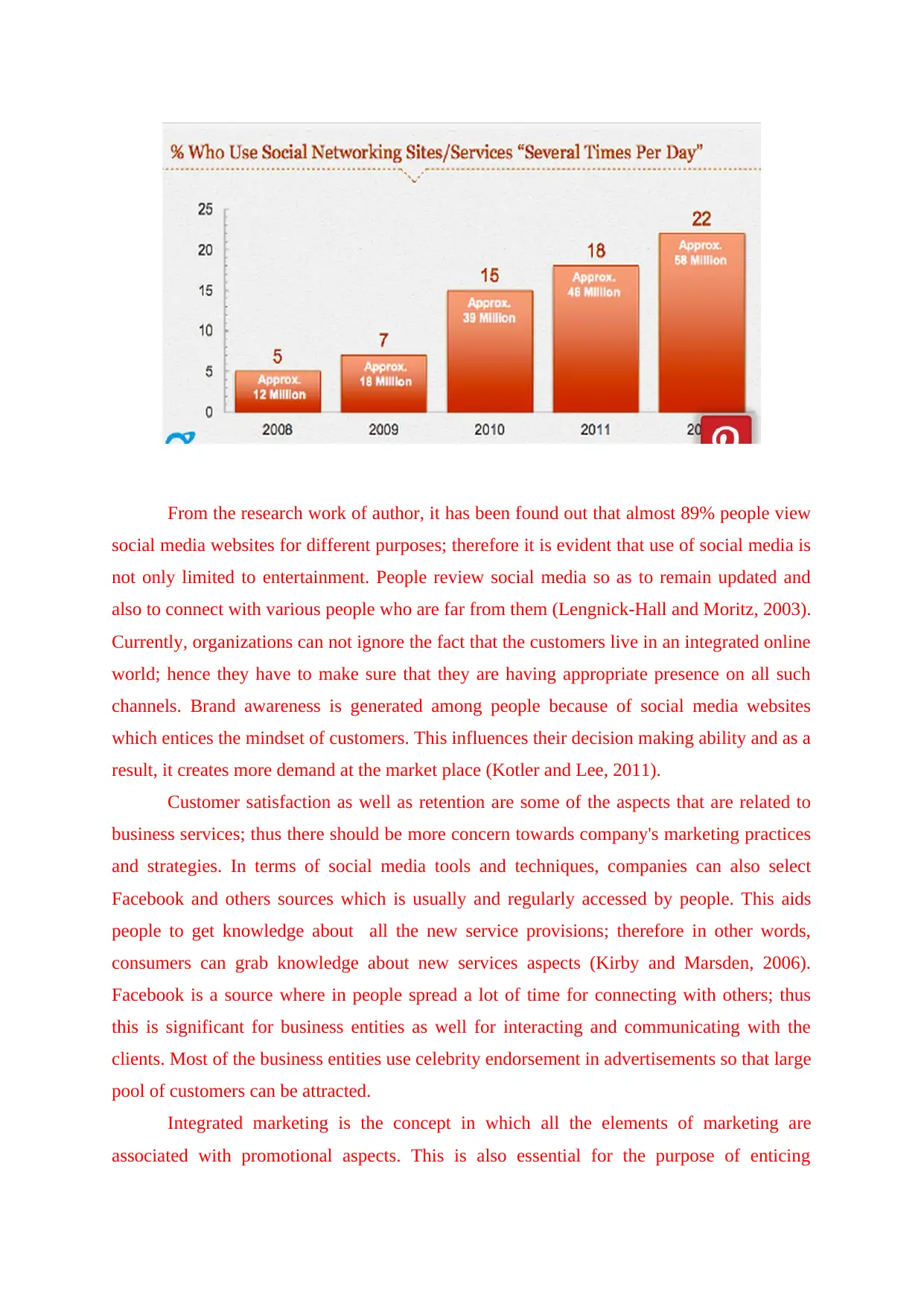
From the research work of author, it has been found out that almost 89% people view
social media websites for different purposes; therefore it is evident that use of social media is
not only limited to entertainment. People review social media so as to remain updated and
also to connect with various people who are far from them (Lengnick-Hall and Moritz, 2003).
Currently, organizations can not ignore the fact that the customers live in an integrated online
world; hence they have to make sure that they are having appropriate presence on all such
channels. Brand awareness is generated among people because of social media websites
which entices the mindset of customers. This influences their decision making ability and as a
result, it creates more demand at the market place (Kotler and Lee, 2011).
Customer satisfaction as well as retention are some of the aspects that are related to
business services; thus there should be more concern towards company's marketing practices
and strategies. In terms of social media tools and techniques, companies can also select
Facebook and others sources which is usually and regularly accessed by people. This aids
people to get knowledge about all the new service provisions; therefore in other words,
consumers can grab knowledge about new services aspects (Kirby and Marsden, 2006).
Facebook is a source where in people spread a lot of time for connecting with others; thus
this is significant for business entities as well for interacting and communicating with the
clients. Most of the business entities use celebrity endorsement in advertisements so that large
pool of customers can be attracted.
Integrated marketing is the concept in which all the elements of marketing are
associated with promotional aspects. This is also essential for the purpose of enticing
social media websites for different purposes; therefore it is evident that use of social media is
not only limited to entertainment. People review social media so as to remain updated and
also to connect with various people who are far from them (Lengnick-Hall and Moritz, 2003).
Currently, organizations can not ignore the fact that the customers live in an integrated online
world; hence they have to make sure that they are having appropriate presence on all such
channels. Brand awareness is generated among people because of social media websites
which entices the mindset of customers. This influences their decision making ability and as a
result, it creates more demand at the market place (Kotler and Lee, 2011).
Customer satisfaction as well as retention are some of the aspects that are related to
business services; thus there should be more concern towards company's marketing practices
and strategies. In terms of social media tools and techniques, companies can also select
Facebook and others sources which is usually and regularly accessed by people. This aids
people to get knowledge about all the new service provisions; therefore in other words,
consumers can grab knowledge about new services aspects (Kirby and Marsden, 2006).
Facebook is a source where in people spread a lot of time for connecting with others; thus
this is significant for business entities as well for interacting and communicating with the
clients. Most of the business entities use celebrity endorsement in advertisements so that large
pool of customers can be attracted.
Integrated marketing is the concept in which all the elements of marketing are
associated with promotional aspects. This is also essential for the purpose of enticing
⊘ This is a preview!⊘
Do you want full access?
Subscribe today to unlock all pages.

Trusted by 1+ million students worldwide
1 out of 20
Related Documents
Your All-in-One AI-Powered Toolkit for Academic Success.
+13062052269
info@desklib.com
Available 24*7 on WhatsApp / Email
![[object Object]](/_next/static/media/star-bottom.7253800d.svg)
Unlock your academic potential
Copyright © 2020–2025 A2Z Services. All Rights Reserved. Developed and managed by ZUCOL.





